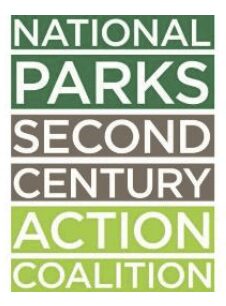
November 19, 2020
Dear Chairwoman Murkowski and Ranking Member Udall, Chairwoman Collins and Ranking Member Reed, Chairwoman McCollum and Ranking Member Joyce, Chairman Price and Ranking Member Diaz-Balart,
We, the members of the National Parks Second Century Action Coalition1The National Parks Second Century Action Coalition is made up of organizations supporting conservation, recreation, outdoor industry, travel and tourism and historic preservation that are dedicated to promoting the protection, restoration, and enjoyment of the National Park System for the long-term benefit it offers our nation., thank you for your investments over the years to our national parks given the constraints to your allocations and competing priorities. As you conference the FY21 appropriations bills, we respectfully ask that you consider our views below on the Interior, Environment and Related Agencies Appropriations bill and Transportation, Housing and Urban Development Appropriations bill.
Subcommittee on Interior, Environment, and Related Agencies:
A growing challenge for the superintendents who manage our parks is insufficient staff to address park needs and welcome record numbers of visitors. Between 2011 and 2019, NPS lost 16% of its staff while at the same time struggling to accommodate a 17% increase in visitation. Parks are short-staffed for many duties including education, interpretation and other visitor services; science; maintenance; resource protection and management; and more. Park budgets generally must absorb increases for retirement and other benefits, salary increases, inflation and other uncontrollable fixed costs. We applaud the increases for park operations in both House and Senate bills and respectfully urge that a conferenced bill provide a level as close as possible to the $200 million provided by the House.
In addition, the recently passed Great American Outdoors Act provides a much needed investment to addressing existing priority repairs within our national parks. However, to address the remaining backlog and to help keep it from growing, we urge you to continue to provide robust investments with no less than last year’s increases in the deferred maintenance operation and construction accounts.
We applaud and agree with the Senate’s concern (Sec. 473(a)) with the lack of detail in the Department of the Interior’s (DOI) first year’s list of deferred maintenance projects. We support the inclusion of the statutory and report language to address that issue. We also support Congress’ direction to DOI (Sec. 473(c)(2)) that projects should not be obligated until Congress has had the opportunity to review the list and consider other allocations.
The Manage Challenge program leverages philanthropic dollars with at least a one-to-one match of federal dollars for signature projects that improve the visiting experience, including deferred maintenance and park programs. During the pandemic, park partners have been unable to assist the park service with maintenance and other projects improving the visitor experience, making these funds all the more valuable as parks recover. Maintaining the Centennial Challenge at a total of $20 million–$15 million directed to NPS and $5 million directed to the National Park Foundation in FY21 as provided in both the House and Senate bills will, at minimum, double nonfederal dollars to improve the visiting experience in parks across the country.
Additionally, the Federal Lands Recreation Enhancement Act (FLREA) authorizes the National Park Service to collect and expend recreation fees to benefit the visitor experience by repairing and improving facilities at national parks, offering education materials and services, and providing law enforcement. Unless FLREA is reauthorized, national parks will lose over $300 million per year. We support the reauthorization of the bill until October 1, 2022 as included in both the House and Senate bills until a longer-term reauthorization bill is completed.
Subcommittee on Transportation, Housing and Urban Development:
Also, the National Park System is second only to the Department of Defense in the amount of federal infrastructure it manages, including 10,000 miles of publicly accessible roads and 1,440 bridges. Even with the passage of the Great American Outdoors Act, half of the backlog remains. We support the House’s funding level of $150 million for the Nationally Significant Federal Lands and Tribal Projects Program in the Transportation, Housing and Urban Development Appropriations bill. This program is popular as evidenced by the over $2.2 billion in requests submitted in FY18 and FY19. This additional funding would help the National Park Service repair large transportation assets throughout the country such as Sunrise Road in Olympic National Park or Brandywine Falls Road and bridge in Cuyahoga Valley National Park.
Finally, Congress established the National Scenic Byways Program in 1991 to preserve and protect the nation’s scenic but often less-traveled roads and promote tourism and economic development. Several national park roads contain or are adjacent to scenic byways. We support and urge that a conferenced bill maintain the Senate’s funding level of $35 million so states can invest in these roads at a time when driving tourism will be most needed and expected.
It is our sincere hope that people will enjoy our national parks to their fullest following the COVID-19 crisis and help restore the economies of the gateway communities. In 2019, 328 million park visitors spent an estimated $21 billion in local gateway regions while visiting NPS lands across the country. These expenditures supported a total of 341 thousand jobs. In addition, America’s outdoor recreation economy supports over five million American jobs and contributes over $788 billion in annual economic output. NPS needs the financial resources to ensure the visitors have the experience they deserve when the parks are reopened fully.
Thank you for considering our views,
The 1882 Foundation
American Hiking Society
American Society of Landscape Architects
Appalachian Trail Conservancy
Atomic Heritage Foundation
Coalition to Protect America’s National Parks
Evangelical Environmental Network
Friends of Acadia
International Inbound Travel Association
National Parks Conservation Association
National Park Hospitality Association
National Park Partners
National Tour Association
National Trust for Historic Preservation
The Pew Charitable Trusts
Public Lands Alliance
Saint Croix River Association
Scenic America
Southeast Tourism Society
United States Tour Operators Association
Voyageurs Conservancy
